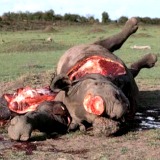South luangwa National Park
Here we will discuss the main wildlife attractions in this Zambian park
South Luangwa national park is a haven for a few unique animals species like the -
- dark necked Thornicrofts giraffes,
- Cooksons wildebeest
and
- Crawshays zebra.
This 9,050-sq km park is centered on the Luangwa valley, which is in the western part of the Great Rift valley.
This is one of Africa's high game density areas.
Three quarters of this remote park is still secluded and largely unexplored with limited visitor numbers.
South Luangwa national park has 60 animal and 400 bird species but has lost its rhinos that have been poached to extinction in 1987.
Thornicrafts giraffes are restricted to Luangwa valley.
These giraffes are distinguished from other giraffes by their dark-brown neck blotches most apparent in older males and lack of blotches on the knees.
Look carefully at the zebras in the South Luangwa national park.
They can be seen moving in small herds of about a dozen.
They are called Crawshay’s zebras.
The difference between these zebras and those in the other areas of Africa are noticeable in their stripes.
Notice that the stripes are -
- thin,
- more numerous and
- extend all the way down to the hooves and under the belly.
They also don’t have the shadow stripes of Burchells zebras.
If you are a keen wildlife photographer, a number of the South Luangwa lodges have photographic hides - where you can set up to get those perfect shots.
The stretch between Mfuwe Lagoon and Luangwa Wafwa is especially good for seeing waterbucks.
They are usually very elusive because they prefer to inhabit densely covered areas.
Antelopes that are more difficult to spot are roans and sables that live mostly in the Muchinga mountains west of the park.
Duikers are nocturnal and shy and also difficult to spot.
Lichtensteins hartebeest are found in the wooded grasslands.
The largest antelope, the eland, can usually seen near the Nsefu sector of the park.
The water loving pukus are rarely seen outside Zambia but is very common in the South Luangwa national park.
When you cross over the bridge into the park you are likely to see a number of hippos in the river.
The Luangwa Valley has one of the highest concentrations of hippos in Africa.
It is estimated that there are at least 50 hippos for every kilometer of the river.
Is it a fact that the hippo is the most dangerous African animal?
In the late afternoon the elephants herds as large as 70 wade across the river.
Best place to see this is probably at Flatdogs camp.
The Luangwa River also has a very high number of crocodiles and it is not uncommon to see them basking in the sun on the banks of the Luangwa Wafwa.
The unusual Cooksons wildebeest in the park are smaller and have a browner belt than other wildebeests.
They are also slightly smaller and more compact than blue wildebeests.
You will notice that -
- Chacma baboons,
- vervet monkeys and
- warthogs are common everywhere in the Luangwa National Park.
The density of leopards in South Lunagwa is among the highest in Africa, although spotting these nocturnal creatures can be tricky.
Some game trackers are very skilled in finding leopards on night drives.
Lions are also plentiful and can often be seen in prides of up to thirty animals.
The other carnivores present in the park that is more difficult to see is the -
- caracal,
- wild dog,
- serval and
- side striped jackal.
Wildlife watching tip
South Luangwa national park is the birthplace of walking safaris.
The walking safari is one of the best ways of experiencing the African wilderness.
It allows you to see all the small creatures and animal spoor that you would pass by in a safari vehicle.
The night drives that you can organize through the lodges, is one of the big attractions in this park.
This provides the chance of seeing leopard and lions plus many other nocturnal hunters that only come to life at night.
This includes -
- genets,
- civets,
- servals,
- hyenas and
- bush babies as well as
- owls,
- nightjars and
- white tailed mongooses.
South luangwa weather
It is important to know the climate and seasonal changes in the Luangwa Valley.
The dry season begins in April and intensifies through to October, the hottest month.
Expect warm sunny days and chilly nights during the dry winter months of May to August.
The wet season begins in November lasts until the end of March and migrant birds arrive in droves.
You should take note that some of the bushcamps close during this time.
South Luangwa national park birdwatching.
There is plenty Bird watching opportunities in the Luangwa Valley.
Here you can find about 400 species of birds that includes 39 birds of prey and 47 migrant species.
Near the end of the dry season in November the river and oxbow lagoons begin to dry out.
This is the time when hundreds of large water birds can be seen wading through the isolated mud pools.
Chipela lagoon has the largest colony of yellow-billed storks in Africa.
Notice how these red faced storks move along with their beaks open underwater.
They disturb the muddy liquid with their feet until the fish flop into their mouths.
The pelicans tend to operate in straight lines.
The techniques they use is to drive the fish before them into shallows before scooping them up into their beaks.
A special sight is the hundreds of migratory and brightly colored carmine bee-eaters nesting in the sandy banks of the river.

